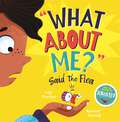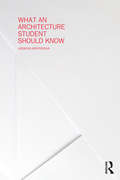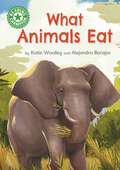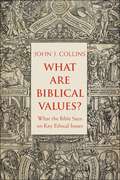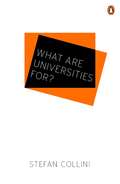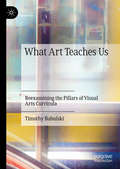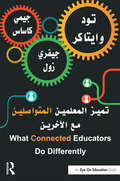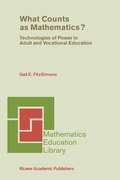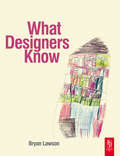- Table View
- List View
What About Me? Said the Flea
by Lily MurrayWhen a little girl sits down at her desk one day to write a story, she struggles to find her inspiration ... Luckily for her there’s a whole host of potential picture-book characters who want to be the star of her story and make their cases convincingly. There’s the magical, proud unicorn with sparkly hooves and a glittery horn. There are the big, burly bears hosting a picnic, the loveable llamas in pyjamas, the stylish sloth, the lion, the penguins, and even a roar-some, claw-some dinosaur …But, unnoticed by the little girl, an even littler flea is hopping and jumping around, hoping to be the one she chooses to write a story about. "What about me?" it cries.With all the big characters and commotion, will the flea ever be noticed?Set in fun, rhyming couplets, What About Me? Said the Flea celebrates the power of imagination, determination, and the good things that come in teeny tiny packages.
What The Academy Taught Us: Improving Schools from the Bottom Up in a Top-Down Transformation Era
by Eric KalenzeEarly in the 2000s, a high-school principal in Minnesota, Dr. Bob Perdaems, faced a complex challenge. The demographics of his school were shifting, political tensions in the surrounding communities were rising, and, thanks to the No Child Left Behind Act's new testing and accountability requirements, his school's performance was soon to be scrutinized more intensely and more publicly than ever before. While he had several visions of how his school could continuously improve through these realities, however, he had no additional budget to bring his ideas to life.Undaunted, Dr. Bob set to creating school improvements the best way he knew how--and that, of course, he could afford: he prioritized his school's areas for growth, found teachers who would lend minds and hands, and gathered them to look at the blueprints. What the Academy Taught Us is a book about the collaborative school-improvement culture Dr. Bob created in his Minnesota high school: the principles that initiated it, the collective effort that kept it running, and the lasting effects it had on its teachers and students. The book also brilliantly explores how bottom-up approaches like Dr. Bob's fare in the current era, which seeks to transform schools through more top-down and 'disruptive' means. Ultimately, What the Academy Taught Us offers today's educators a way forward. While largely viewing the difficult work of school improvement through the prism of a single school, it presents abundant recommendations about how schools everywhere can build effective and continuous improvement from the bottom up.
What an Architecture Student Should Know
by Jadwiga KrupinskaIt's not just you. Every architecture student is initially confused by architecture school - an education so different that it doesn't compare to anything else. A student’s joy at being chosen in stiff competition with many other applicants can turn to doubt when he or she struggles to understand the logic of the specific teaching method. Testimony from several schools of design and architecture in different countries indicates that many students feel disoriented and uncertain. This book will help you understand and be aware of: Specific working methods at architecture schools and in the critique process, so you'll feel oriented and confident. How to cope with uncertainty in the design process. How to develop the ability to synthesize the complexity of architecture in terms of function, durability, and beauty. This book is about how architects learn to cope with uncertainty and strive to master complexity. Special attention is given to criticism, which is an essential part of the design process. The author, a recipient of several educational awards, has written this book for architecture students and teachers, to describe how each student can adopt the architect's working method. Key concepts are defined throughout and references at the end of each chapter will point you to further reading so you can delve into topics you find particularly interesting. Jadwiga Krupinska is professor emerita at the School of Architecture of the Royal Institute of Technology (KTH) in Stockholm, Sweden.
What an Architecture Student Should Know
by Jadwiga KrupinskaIt's not just you. Every architecture student is initially confused by architecture school - an education so different that it doesn't compare to anything else. A student’s joy at being chosen in stiff competition with many other applicants can turn to doubt when he or she struggles to understand the logic of the specific teaching method. Testimony from several schools of design and architecture in different countries indicates that many students feel disoriented and uncertain. This book will help you understand and be aware of: Specific working methods at architecture schools and in the critique process, so you'll feel oriented and confident. How to cope with uncertainty in the design process. How to develop the ability to synthesize the complexity of architecture in terms of function, durability, and beauty. This book is about how architects learn to cope with uncertainty and strive to master complexity. Special attention is given to criticism, which is an essential part of the design process. The author, a recipient of several educational awards, has written this book for architecture students and teachers, to describe how each student can adopt the architect's working method. Key concepts are defined throughout and references at the end of each chapter will point you to further reading so you can delve into topics you find particularly interesting. Jadwiga Krupinska is professor emerita at the School of Architecture of the Royal Institute of Technology (KTH) in Stockholm, Sweden.
What Animals Eat: Independent Reading Green 5 Non-fiction (Reading Champion #515)
by Katie WoolleyThis story is part of Reading Champion, a series carefully linked to book bands to encourage independent reading skills, developed with Dr Sue Bodman and Glen Franklin of UCL Institute of Education (IOE) Reading Champion offers independent reading books for children to practise and reinforce their developing reading skills. Fantastic, original stories are accompanied by engaging artwork and a reading activity. Each book has been carefully graded so that it can be matched to a child's reading ability, encouraging reading for pleasure.
What Are Biblical Values?: What the Bible Says on Key Ethical Issues
by John CollinsAn illuminating exploration of the Bible and many of our most contentious contemporary issues Many people today claim that their positions on various issues are grounded in biblical values, and they use scriptural passages to support their claims. But the Bible was written over the course of several hundred years and contains contradictory positions on many issues. The Bible seldom provides simple answers; it more often shows the complexity of moral problems. Can we really speak of “biblical values”? In this eye-opening book, one of the world’s leading biblical scholars argues that when we read the Bible with care, we are often surprised by what we find. Examining what the Bible actually says on a number of key themes, John Collins covers a vast array of topics, including the right to life, gender, the role of women, the environment, slavery and liberation, violence and zeal, and social justice. With clarity and authority, he invites us to dramatically reimagine the basis for biblical ethics in the world today.
What are Universities For?
by Stefan ColliniAcross the world, universities are more numerous than they have ever been, yet at the same time there is unprecedented confusion about their purpose and scepticism about their value. What Are Universities For? offers a spirited and compelling argument for completely rethinking the way we see our universities, and why we need them. Stefan Collini challenges the common claim that universities need to show that they help to make money in order to justify getting more money. Instead, he argues that we must reflect on the different types of institution and the distinctive roles they play. In particular we must recognize that attempting to extend human understanding, which is at the heart of disciplined intellectual enquiry, can never be wholly harnessed to immediate social purposes - particularly in the case of the humanities, which both attract and puzzle many people and are therefore the most difficult subjects to justify.At a time when the future of higher education lies in the balance, What Are Universities For? offers all of us a better, deeper and more enlightened understanding of why universities matter, to everyone.
What are you staring at?: A Comic About Restorative Justice in Schools (PDF)
by Joseph Wilkins Pete WallisDesigned for use in schools, this comic teaches children about restorative justice through the story of Jake and Ryan. After a misunderstanding between Jake and Ryan leads to a fight in the playground, both boys are left feeling angry and fearful about what might happen when they see each other again. Rather than keeping Jake and Ryan apart, their teacher arranges a restorative meeting to allow the boys to understand the situation from the other's perspective and transform their negative emotions into positive ones. This comic is a key resource in helping children aged 8-13 to understand restorative justice and prepare for a restorative meeting. The comic also features a resource section for teachers, explaining more about restorative practices and how they can be used in schools to foster respect and emotional literacy among students.
What Art Teaches Us: Reexamining the Pillars of Visual Arts Curricula
by Timothy BabulskiThis book critically examines four areas common to visual arts curricula: the elements of art and principles of design, the canons of human proportions, linear perspective, and RYB color theory. For each, the author presents a compelling case detailing how current art teaching fails students, explores the history of how it came to be part of the discourse, and then proffers cognitivist and holistic alternatives. This book provides a framework for teachers and teacher-candidates to shape how they advocate for intellectual rigor and embodied learning and, importantly, how they can subvert an existing curriculum to better meet the educational needs of their students.
What Can Behavioral Economics Teach Us about Teaching Economics?
by Supriya SarnikarSarnikar cites evidence of frequent misconceptions of economics amongst students, graduates, and even some economists, and argues that behavioral economists are uniquely qualified to investigate causes of poor learning in economics. She conducts a review of the economics education literature to identify gaps in current research efforts and suggests a two-pronged approach to fill the gaps: an engineering approach to the adoption of innovative teaching methods and a new research program to enhance economists' understanding of how learning occurs. To facilitate research into learning processes, Sarnikar provides an overview of selected learning theories from psychology, as well as new data on hidden misconceptions amongst beginning students of economics. She argues that if they ask the right questions, economists of all persuasions are likely to find surprising lessons in the answers of beginning students of economics.
What Can PISA 2012 Data Tell Us?: Performance and Challenges in Five Participating Southeast Asian Countries
by Lei Mee Thien Nordin Abd Razak John P. Keeves I. Gusti Ngurah DarmawanThis is the first book regarding the issues of PISA that has been published with respect to the Southeast Asian region. It is hoped that the content of this book can benefit and provide greater understanding for readers of several important aspects: (a) country performance in PISA 2012 for each participating Southeast Asian country, (b) the need for international comparative studies from the perspective at all levels of the teaching and learning process, (c) equity and quality of education, (d) how PISA impacts on policy making, and (e) the initiatives and future directions, and challenges to improve PISA performance in the future cycles of the PISA Studies. The major issues raised in this book warrant investigation and reporting to all countries of the World, including not only those countries that were engaged in PISA 2012, but also to the approximately 200 countries that are currently in the United Nations Organisation. In these regards, the readership of this book could be extended to the educators, officers from the ministries of education, researchers, policy makers, practising teachers, lecturers in universities and teacher training institutions, postgraduate students, as well as both primary and secondary school principals and teachers.
What comes before phonics?
by Dr Sally NeaumThe teaching of phonics is now strongly embedded in early literacy teaching and early years settings, and it has been shown to be an important part of becoming literate. There is, however, significant concern about the formalizing of phonics teaching for very young children. So what should we be focusing on in early years? What comes before this formal teaching? What do children need to know and experience to enable them to access phonics teaching with success? This book looks in detail at the knowledge, understanding, skills and attitudes that children need to enable them to come to phonics teaching ready to learn and with a good chance of success. It explores a range of aspects of young children’s learning and includes practical advice on how to translate this into practice.
What comes before phonics?
by Sally NeaumWhat comes before phonics? The teaching of phonics is now strongly embedded in early literacy teaching in schools and early years settings, and it has been shown to be an important part of becoming literate. There is, however, significant concern about the formalising of phonics teaching for very young children. So what should we be focusing on in early years? What comes before this formal teaching? What do children need to know and experience to enable them to access phonics teaching with success? This book looks in detail at the knowledge, understanding, skills and attitudes that children need to enable them to come to phonics teaching ready to learn and with a good chance of success. The second edition has been updated to include the latest research and enhanced support on working with parents and carers.
What comes before phonics?
by Sally NeaumWhat comes before phonics? The teaching of phonics is now strongly embedded in early literacy teaching in schools and early years settings, and it has been shown to be an important part of becoming literate. There is, however, significant concern about the formalising of phonics teaching for very young children. So what should we be focusing on in early years? What comes before this formal teaching? What do children need to know and experience to enable them to access phonics teaching with success? This book looks in detail at the knowledge, understanding, skills and attitudes that children need to enable them to come to phonics teaching ready to learn and with a good chance of success. The second edition has been updated to include the latest research and enhanced support on working with parents and carers.
What comes before phonics?
by Sally NeaumWhat comes before phonics? The teaching of phonics is now strongly embedded in early literacy teaching in schools and early years settings, and it has been shown to be an important part of becoming literate. There is, however, significant concern about the formalising of phonics teaching for very young children. So what should we be focusing on in early years? What comes before this formal teaching? What do children need to know and experience to enable them to access phonics teaching with success? This book looks in detail at the knowledge, understanding, skills and attitudes that children need to enable them to come to phonics teaching ready to learn and with a good chance of success. The second edition has been updated to include the latest research and enhanced support on working with parents and carers.
What comes before phonics? (PDF)
by Dr Sally NeaumThe teaching of phonics is now strongly embedded in early literacy teaching and early years settings, and it has been shown to be an important part of becoming literate. There is, however, significant concern about the formalizing of phonics teaching for very young children. So what should we be focusing on in early years? What comes before this formal teaching? What do children need to know and experience to enable them to access phonics teaching with success? This book looks in detail at the knowledge, understanding, skills and attitudes that children need to enable them to come to phonics teaching ready to learn and with a good chance of success. It explores a range of aspects of young children’s learning and includes practical advice on how to translate this into practice.
What Connected Educators Do Differently
by Todd Whitaker Jeffrey Zoul Jimmy CasasTodd Whitaker, Jeffrey Zoul, and Jimmy Casas are widely acclaimed experts on teaching and leading and are pioneers in the education twitterverse, and now they are sharing their best practices! In What Connected Educators Do Differently, they show how being a connected educator—by using social media to connect with peers across the country and even across the globe—will greatly enhance your own learning and your success in a school or classroom. You’ll find out how to create a personal and professional learning network to share resources and ideas, gain support, and make an impact on others. By customizing your professional development in this way, you’ll be able to learn what you want, how you want, when you want. Best of all, you’ll become energized and inspired by all the great ideas out there and how you can contribute, benefiting both you and your students. Whether you are a teacher or school leader, you will come away from this book with step-by-step advice and fresh ideas to try immediately. Being a connected educator has never been easier or more important than it is right now!
What Connected Educators Do Differently: Arabic Edition
by Todd Whitaker Jeffrey Zoul Jimmy CasasTodd Whitaker, Jeffrey Zoul, and Jimmy Casas are widely acclaimed experts on teaching and leading and are pioneers in the education twitterverse, and now they are sharing their best practices! In What Connected Educators Do Differently, they show how being a connected educator—by using social media to connect with peers across the country and even across the globe—will greatly enhance your own learning and your success in a school or classroom. You’ll find out how to create a personal and professional learning network to share resources and ideas, gain support, and make an impact on others. By customizing your professional development in this way, you’ll be able to learn what you want, how you want, when you want. Best of all, you’ll become energized and inspired by all the great ideas out there and how you can contribute, benefiting both you and your students. Whether you are a teacher or school leader, you will come away from this book with step-by-step advice and fresh ideas to try immediately. Being a connected educator has never been easier or more important than it is right now!
What Connected Educators Do Differently
by Todd Whitaker Jeffrey Zoul Jimmy CasasTodd Whitaker, Jeffrey Zoul, and Jimmy Casas are widely acclaimed experts on teaching and leading and are pioneers in the education twitterverse, and now they are sharing their best practices! In What Connected Educators Do Differently, they show how being a connected educator—by using social media to connect with peers across the country and even across the globe—will greatly enhance your own learning and your success in a school or classroom. You’ll find out how to create a personal and professional learning network to share resources and ideas, gain support, and make an impact on others. By customizing your professional development in this way, you’ll be able to learn what you want, how you want, when you want. Best of all, you’ll become energized and inspired by all the great ideas out there and how you can contribute, benefiting both you and your students. Whether you are a teacher or school leader, you will come away from this book with step-by-step advice and fresh ideas to try immediately. Being a connected educator has never been easier or more important than it is right now!
What Counts as Credible Evidence in Applied Research and Evaluation Practice?
by Stewart I. Donaldson Christina A Christie Melvin M. MarkWhat Counts as Credible Evidence in Applied Research and Evaluation thoroughly covers one of the most fundamental issues facing applied research and evaluation practice today – what counts as sound evidence for decision making? An internationally renowned line up of authors explore a wide range of issues that address the fundamental challenges of designing and executing high quality applied research and evaluation studies. Readers will come away from this volume with a new and clear understanding of the philosophical, theoretical, methodological, political, and ethical dimensions of gathering credible evidence to answer fundamental research and evaluation questions across diverse disciplinary boundaries and "real world" contexts.
What Counts as Mathematics?: Technologies of Power in Adult and Vocational Education (Mathematics Education Library #28)
by Gail E. FitzSimonsThis book presents an institutional study located at the intersection mathematics education and vocational education. Using the concept of technology as a unifying theme, it presents a critique of neoliberalist policies and their impact upon curriculum, teachers' work, and the apparent de-institutionalization of vocational education - with particular reference to mathematics education and the consequences for adult students as (potential) workers and citizens.
What Counts in Teaching Mathematics: Adding Value to Self and Content (Self-Study of Teaching and Teacher Education Practices #11)
by Sandy Schuck and Peter PereiraIn this book, internationally recognised scholars and practitioners synthesise current practice and research developments in the area of mathematics teacher education and mathematics education. The book’s two sections examine the role and significance of collaborations and critical friends in the self-study of mathematics teaching and teacher education; and the emerging conflicts, dilemmas and incongruities arising from the study of mathematics education practices. The book considers the insights gained from self-analysis regarding the practitioner themselves, as well as their pedagogical content, students and approaches. The contributions highlight the complexity, characteristics and features of mathematics education.The chapters reveal nuances in teaching and learning that are of particular relevance in mathematics education. In addition, the book contains ideas and suggestions on how to enhance the teaching of mathematical content to pre-service teachers. Accordingly, the book appeals to a wide audience of educators—including education academics, teachers, student teachers and researchers. As teacher educators involved in mathematics education, reflection on practice and engagement in practitioner research is becoming increasingly important in our efforts to enhance our teaching. Teachers and student teachers also gain from the insights arising from such reflection. The knowledge and experience encapsulated in this book provides much for the mathematics education community to build on.
What Curriculum for the Information Age
by M. A. WhiteFirst Published in 1987. Routledge is an imprint of Taylor & Francis, an informa company.
What Curriculum for the Information Age
by Mary Alice WhiteFirst Published in 1987. Routledge is an imprint of Taylor & Francis, an informa company.
What Designers Know
by Bryan LawsonEach chapter deals with a different technique from which we can best represent and make explicit the forms of knowledge used by designers. The book explores whether design knowledge is special, and attempts to get to the root of where design knowledge comes from. Crucially, it focuses on how designers use drawings in communicating their ideas and how they ‘converse’ with them as their designs develop. It also shows how experienced designers use knowledge differently to novices suggesting that design ‘expertise’ can be developed. Overall, this book builds a layout of the kinds of skill, knowledge and understanding that make up what we call designing.
